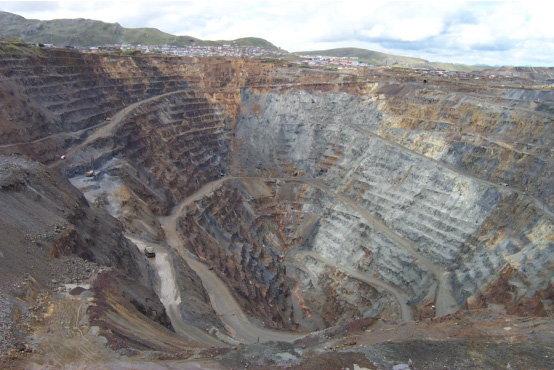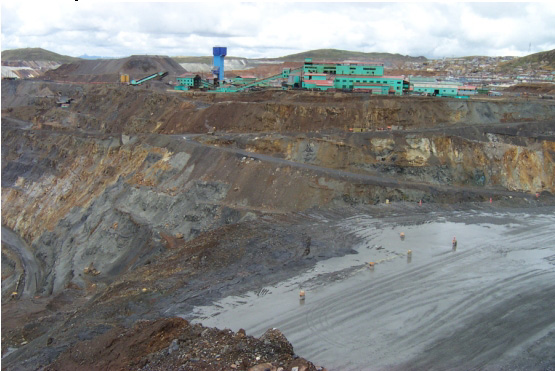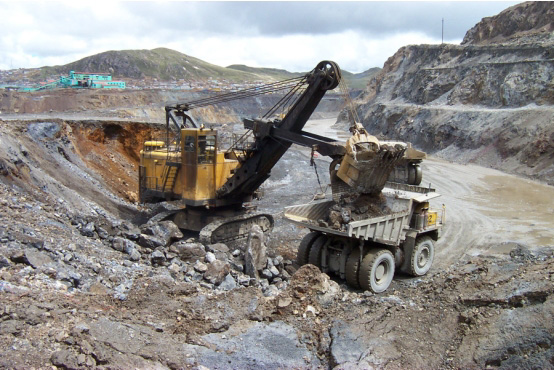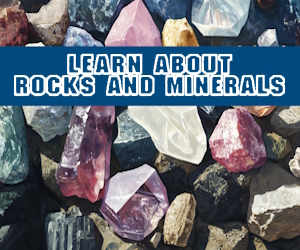English
Castellano
CatalÃ
Cerro de Pasco, Peru
Author: Martin Mount
Content by courtesy of : Dan Weinrich www.danweinrich.com
Reproduction of text and photos prohibited without permission of author.

This is the main open pit. Quite a hole – measuring about 2km north-south by about 1km east-west (left to right) and around 350m. in depth. We are currently pushing back the east wall (you can see some of the equipment) and considering a proposal to deepen by about another 100m. The city of Cerro de Pasco surrounds the pit to the south (the bit you can see in the distance), the east and northeast. The deposit sits inside one side of a collapsed volcanic neck. The grey material centre to right is almost solid pyrite containing about 5oz/tonne of silver. The underground mine is mostly under the open pit. Current production around 2.5 million tonnes per year grading about 7.5%Zn, 2.5%Pb and 1ozAg.
Some more photos follow >>>>

As happens with a lot of large open pits, the concentrator was not sited far enough away from the pit and is now sitting on the north-west edge. There may be a need to rebuild the concentrator further away in the not so distant future. Also, the main hoisting shaft (Lourdes - blue) is in the way.

Cerro was originally a silver mine (18th-19th Century) where the worked in and under the oxide cap. In the 1820Â’s when the mine was getting difficult to drain they called in Richard Trevithick to design and install various pumping engines to drain the mines and work deeper. It took 3 years to make the engines (in Hayle, Cornwall), take them to Peru by sailing ship and drag them 350km over the mountains before installing them in Cornwall style engine-houses. By this time, the company had no money to pay the bill (a familiar story). Trevithick took up an interest in the mine as a result, but never did get his money back and died as a pauper as a direct result.
The mine was given new life in 1906 when the Cerro De Pasco Copper Company (later called Corporation) took up the property. They started mining a series of sub-vertical fissure veins striking East-West through the main mineralised zone and mined these to about 2,000 feet (600m) in depth. In the late 1940’s when the copper was largely worked out a decision was made to start working the Pb-Zn orebodies which had up to that time remain unworked. Pb and Zn were much more in demand and flotation technology was now available to recover the sulphide minerals. A decision was made to move the town and the open pit was started (the equipment bought is still in use today – above photo refers).

In the early 1970Â’s the mine was taken over by Centromin the State mining company as part of a nationalisation program. They continued to work the Pb-Zn deposits but invested very little money in the mine. In 1999 the mine was purchased by Volcan Compania Minera as part of a proposal to privatise the mines once more. This has put new life into the mine and area and sufficient reserves and resources have been found to guarantee another 10 to 15 years of production. There could be much more.
There are two concentrators. The main one Paragsha treats 8,500 tonnes per day. There are some 15 mills like this one. Modifications are currently taking place to increase capacity to about 9,500 tpd by the end of this year.
Volcan with its other mines is now 4th largest Zinc producer in the World and about 11th highest Silver producer, and largest producer for Zinc, Lead and Silver in Peru.
Information | Mineral photos | VIDEOS | Articles | Fairs | Web directory | Classified ads | Minerals Books | Shop




